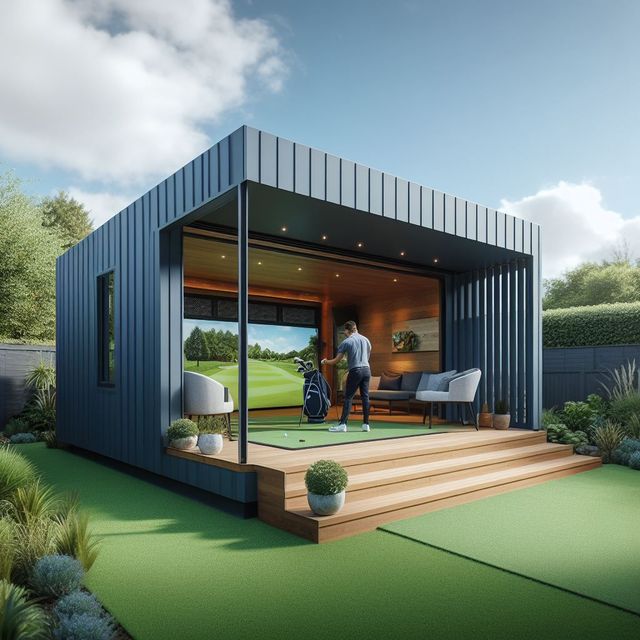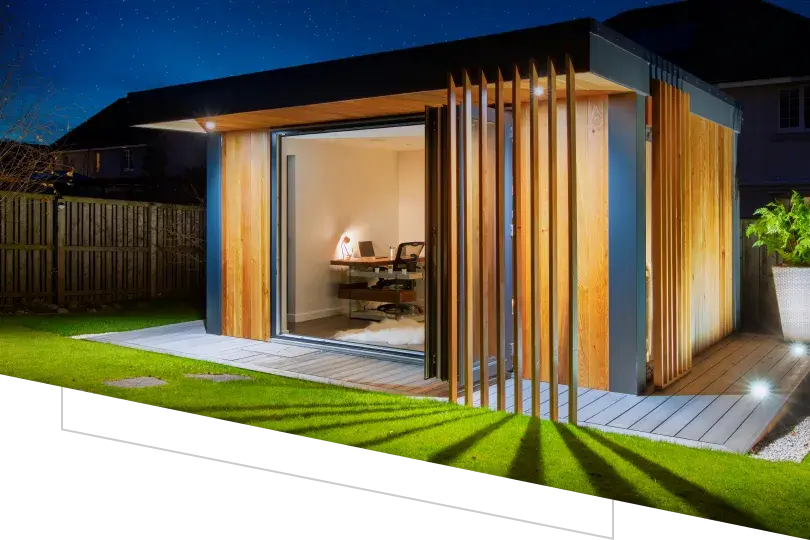Good Tips On Planning Permission For Garden Sheds
What Planning Permission Is Required For Gardens, Rooms, Etc. With Regard To Changes Of Use?Planning permission is required for the construction of gardens, conservatories, and outhouses. Planning permission is required to make changes in usage.
In most cases the planning permit will be required to transform non-residential structures (such as garages or agricultural structures) to residential areas or gardens offices. This is because it involves a change in the use type of the building.
Garden Rooms: Living Area
It's considered to be as a "change of use" in the event that you decide to convert the garden into a separate accommodation, such as an apartment for guests. The building must be approved by the local planning authority in order in order to comply with residential standards.
Business Use:
The planning permission is required if the extension or garden room is used for business use. This is due to potential impact on your neighborhood, such as the noise, traffic and parking.
Educational or Community Use
Changes in the use of a garden building to be an educational or community space (such as a classroom or meeting hall) is also a requirement for permission for planning. The local authority evaluates the area's potential and impacts on the surrounding areas.
Impact on Local Infrastructure
Typically, any change of use that impacts the local infrastructure (such as roads, drainage or public services) will require planning permission. The local planning authority will consider these effects during the application process.
Dual Use
Planning permits are required for properties that have a mixed-use (part residential, part commercial) to define and regulate the various uses of the property.
Increased footfall and traffic:
Planning permission may be required depending on whether the new use is likely to increase pedestrian or vehicular traffic (e.g. changing an unimportant garden space into retail space). This is to mitigate any potential adverse impact on the neighborhood.
Regulations for Building Regulations Conformity:
Although it's not a strict matter of planning approval, each change in usage must be in compliance with construction regulations. This is to ensure security, health standards, and energy efficiency. This is particularly true when it comes to conversions of non-habitable areas into habitable spaces.
Environmental Impact:
Planning approval is required for all changes of use which could be detrimental to the environment. Examples include converting agricultural land to residential uses. An environmental study may be required in the application.
Effect on Community and Amenities:
It is crucial to think about the impact that the change will have on the community facilities in the area, as well as the overall character of the place. As an example the idea of transforming a room within the garden to a coffee shop would require planning permission. This is to ensure that it is in line with community plans while preserving local amenities.
Designated Areas:
In designated zones (such such as National Parks and Areas of Outstanding Natural Beauty), there are stricter rules to ensure the nature of the area is preserved. This is why planning permission is required.
Local Planning Policy:
Local planning authorities have specific policies regarding change of use, which can vary in a significant way. It is recommended to read these policies so you know what kinds of changes are permitted and what requirements need to be fulfilled.
Planning permits are typically required to make a major change in the use or place of a gardenroom, conservatory outhouse, office, or extension. It ensures the new use is appropriate for the location, in line with the local and national guidelines and will address any potential impact on the community or environment. It is important to consult with the local authorities on planning at an early stage in the process, to determine the exact requirements and get the required approvals. Follow the best northwest bifolds for more advice including garden office hertfordshire, conservatories and garden rooms, ground screws vs concrete base, garden room permitted development, Tring garden rooms, conservatories and garden rooms, what size garden room without planning permission, luxury outhouse, garden office, myouthouse and more.

What Planning Permits Are Required For Gardens, Rooms, Etc. With Respect To Listed Structures?
Special considerations and regulations are required when making conservatories, garden rooms or outhouses within the boundaries of a building that is listed as heritage. These are the most important aspects of planning permissions for such projects. Listed Building Consent
Generally, any extension, alteration or construction project that is carried out within the perimeter of a protected building requires approved listed building permits in addition to planning permission. These are because any changes could affect the character and interest of the listed property.
The impact on the character of historic buildings
Planning permission is necessary for any new building or extension that might alter the appearance or historical character of the listed building or its surroundings. In this category are garden rooms and outbuildings.
Design and Materials
The style and materials should reflect the historical and architectural significance of the current building. This could require custom designs and the usage of traditional materials requiring the approval of a planner.
Distance from the listed Building
New structures constructed close to the historic building will be inspected for their effect on the design and appearance of the heritage property. If they do not affect the building’s character, planning permission will need to be sought.
Size and Scale:
The proposed size of the garden room, conservatory or extension should be proportionate to the existing building. Planning approval and thorough evaluations are more likely for larger structures.
The location of the property
Planning permission may be affected by the site of a new structure regardless of whether it is front, on the side, or in the rear of a listed building. Locations that are visible or impacting key views of the building usually require more rigorous review.
Internal Changes
Even if it is an unattached structure, any changes to the interior to a listed building (such the creation of new entry points) require planning permission and listed-building consent.
Conservation Area Overlap
If the building also falls within a conservation area additional restrictions apply. Planning permits are required to comply with both the listed building and conservation zone regulations.
The use of the building:
The location of an outbuilding, or a garden room can impact the need to obtain a permit for planning. The use of an outbuilding or garden space that implies a major modification to the property like a residential unit or commercial space, is subject to greater scrutiny.
Impact on structural structure:
Planning approval is needed for any construction which could impact the structural integrity or structure. This ensures that the old and new structures are integrated seamlessly.
Local Authority Guidelines
Local authorities usually provide specific guidelines to listed buildings that outline the kinds of construction and modifications that can be permitted. Planning permission ensures that these guidelines are followed.
Professional Assessments
Conservationists typically conduct detailed analyses when reviewing plans to build on listed structures. These assessments are made to determine if the proposed changes are suitable and to support the application for planning permission.
In short planning permission, listed building consents are nearly always required when constructing garden rooms, conservatories outhouses, garden offices, or extensions associated with a listed building. An early consultation with local experts in heritage and the planning authorities is essential to ensure that all rules are adhered to and that the historical and architectural integrity of a property is maintained. Read the top 5 counties garden rooms for site examples including herts garden rooms, my outhouse, Tring garden rooms, Tring garden rooms, what size garden room without planning permission, garden room conservatory, garden rooms near me, what size garden room without planning permission uk, small garden office, what is a garden room and more.

What Planning Permission Are You Requiring For Garden Rooms Etc In Terms Of Appearance And Design?
The design and appearance of the structure will determine whether planning permission is required for the construction of conservatories, garden offices or outhouses, as well as gardens rooms. Here are the most crucial considerations.
Planning permission may not be required if the structure you want to build is within the permitted development right of your property. There are, however, certain design and appearance standards that must be met.
Size and Scale
The size and scale of the new structure should be in proportion to the property's existing size and buildings around it. If the structure is greater than the permitted size limit, planning approval is required.
Height and Mass:
The new structure's height and mass should be in line with the surrounding structures as well as the property. Planning permits are typically required for structures that exceed the height limits or are incompatible by the size of the land.
Materials and Finishes
The selection of materials and finishing should complement existing structures and properties around the area. If the materials proposed are not compatible with the local style and design, planning permission may be required.
Design Harmony
The style of the proposed structure should match the architectural design and style of the house or other structures surrounding it. If the design proposed is not in keeping with the local character and appearance, planning permission will be required.
Roof Design
The style of the roof must be in harmony with the existing architecture and that of buildings surrounding it. It may be necessary to obtain permission for planning if the proposed roofing design does not fit in with the local style or design.
Fenestration, Windows and Doors:
The design and location of windows and entrances should be compatible with the existing building and surroundings. Planning permission might be needed in the event that the proposed fenestration design isn't in harmony with the local character and appearance.
Facade Treatment:
Facades should be considered in a way that is harmonious with surrounding structures and properties. The proposed facade might require planning permission if it is not in keeping with the surrounding buildings.
Landscape and Surroundings
The landscaping of the new structure around it will be in harmony with the existing structures and the property. Planning permission may be required if proposed landscaping does not fit with the local character and appearance.
Visual Impact:
The visual impact of the structure on the surrounding area should be minimized. The proposed structure could require planning permission if it has an adverse aesthetic impact on the surroundings.
Heritage and Conservation Areas
If the property is in an area designated as a heritage or conservation zone There may be more stringent criteria for design and appearance. Any new structure that does not meet these requirements may require approval from the planning department.
Guidelines for architectural and planning:
Local planning agencies typically have strict guidelines for design and appearance. Planning permission might be needed when a building proposal isn't in accordance with these guidelines.
In the end, the planning approval for garden rooms, conservatories, outhouses, gardens offices, or extensions typically depends on the style and design of the structure being proposed. It is essential to speak with your local planning authority at an early stage of the planning process to ensure that you are complying with local guidelines regarding character and appearance and decide if planning permission is required. Check out the recommended insulated garden room with electricity for website recommendations including garden buildings , luxury outhouse, garden room heater, garden buildings , insulated garden rooms, garden outhouses, insulated garden buildings, how to get power to a garden room, what size garden room without planning permission, garden office electrics and more.
